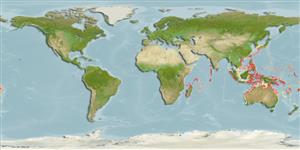Actinopterygii (ray-finned fishes) >
Perciformes (Perch-likes) >
Gobiidae (Gobies) > Gobiinae
Etymology: Pleurosicya: Greek, pleura = side, ribe + Greek, sikya, -as = cucumber (Ref. 45335). More on author: Larson.
Environment / Climate / Range
Ecology
Marine; reef-associated; non-migratory; depth range 10 - 40 m (Ref. 90102). Tropical, preferred ?
Indo-West Pacific: Maldives (Ref. 30829) to Indonesia (Ref. 8631) and Papua New Guinea (Ref. 6771).
Size / Weight / Age
Maturity: Lm ? range ? - ? cm
Max length : 4.0 cm SL male/unsexed; (Ref. 48637)
Dorsal
spines
(total): 6 - 7;
Dorsal
soft rays
(total): 8-9;
Anal
spines: 1;
Anal
soft rays: 6 - 9. Characterized by generally with yellow to pinkish hue, scale margins faint and dark; series of internal brown dash-like markings along vertebral column; ventral side of body with seven brown spots; side of snout white stripe; longitudinal scale series 23-27; side of nape scaled; opening of gill restricted to pectoral fin-base; elongated body; depth of body at anus6.2-8.3 in SL (Ref. 90102).
Inhabits coloured, large floppy or fan sponges, usually in depths greater than 10 meters. Found on the underside of the sponges (Ref. 48637).
Life cycle and mating behavior
Maturity | Reproduction | Spawning | Eggs | Fecundity | Larvae
Kailola, P.J., 1991. The fishes of Papua New Guinea: a revised and annotated checklist. Vol. III. Gobiidae to Molidae. Research Bulletin No. 41, Research Section, Dept. of Fisheries and Marine Resources, Papua New Guinea. 153 p. (Ref. 6771)
IUCN Red List Status (Ref. 115185)
CITES (Ref. 94142)
Not Evaluated
Threat to humans
Harmless
Human uses
More information
Common namesSynonymsMetabolismPredatorsEcotoxicologyReproductionMaturitySpawningFecundityEggsEgg development
ReferencesAquacultureAquaculture profileStrainsGeneticsAllele frequenciesHeritabilityDiseasesProcessingMass conversion
Tools
Special reports
Download XML
Internet sources
